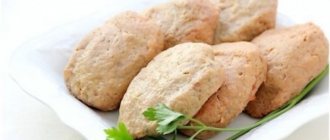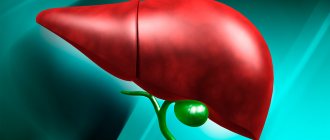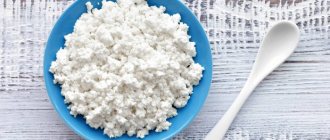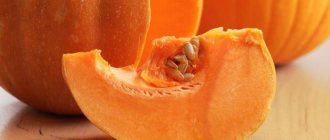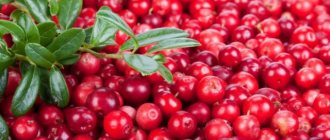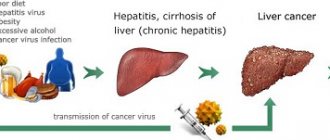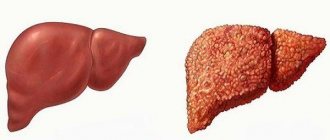General rules
Liver cirrhosis to the final stage of diffuse morphological changes in the liver, characterized by disruption of the structure of hepatitis and the lobular structure of the organ, caused by progressive irreversible fibrosis and the formation of regeneration nodules with the development of portal hypertension and liver failure. The main etiological factors of the disease are:
- viral hepatitis B , C , D ;
- alcoholic/non-alcoholic steatohepatitis and hepatitis;
- violation of venous outflow from the liver;
- metabolic syndrome accompanied by fatty hepatosis;
- long-term intra/extrahepatic cholestasis .
The frequency and severity of clinical manifestations depend on the stage of the disease and the level of compensation. Compensated cirrhosis of the liver, as a rule, is asymptomatic / with minimal atypical manifestations, such as asthenovegetative syndrome (increased fatigue, irritability, weakness, decreased performance, tearfulness, touchiness, tendency to hysteria), heaviness / pain in the right hypochondrium, spider veins on the skin , bitterness in the mouth, nausea, vomiting, jaundice. At the stage of decompensation - joint pain, itching, portal hypertension (increased blood pressure in the portal vein), leading to ascites , bleeding from the esophageal veins, liver failure .
Basic therapy consists of eliminating the effects of etiological factors (alcohol, toxic drugs, occupational/domestic hazards), drug therapy (antiviral, hepatoprotective), diet, treatment of complications/concomitant diseases. Treatment of liver cirrhosis with nutrition is the most important factor, which allows, against the background of other therapeutic measures, to slow down the activity of the pathological process.
The question of what kind of diet for liver cirrhosis is resolved in favor of the classical therapeutic Table No. 5 according to Pevzner, although a number of authors believe that with compensated liver cirrhosis and the patient’s normal well-being, dietary restrictions are not required (except for the absolute ban on alcohol), since there is reliable data on There is no therapeutic effect when giving up eggs, butter, spices, coffee and other foods. However, traditional dietetics offers a moderately restrictive diet for liver cirrhosis with limited fats of animal origin, aimed at mechanical/chemical sparing of the liver, normalizing its function and the process of bile secretion.
Dietary nutrition involves limiting the content in the diet of refractory animal fats and salt, products containing nitrogenous extractives, purine bases, cholesterol, oxalic acid, coarse fiber, and essential oils. At the same time, the content of the protein component should be at the level of 1-1.5 g/kg body weight/day. The diet provides for an increased content in the diet of foods that have a lipotropic effect (buttermilk, cottage cheese, whey, buckwheat, fiber, vegetable oils) and fruits containing pectin .
Excluded from the diet are canned food, smoked meats, sausages, all types of fatty meat/fish, concentrated broths, refractory animal fats, vegetables and legumes that contain large quantities of coarse fiber and essential oils - raw garlic and onions, radishes/radishes, mushrooms, hot marinades, herbs, spices and sauces, vinegar, baked goods, full-fat milk/cream, cakes, pastries. It is extremely important to exclude toxic ingredients from the diet (chemical food additives, products of fat oxidation and frying/deep-frying). Methods of preparing food - boiling, stewing, baking.
In the presence of complications (edematous-ascitic syndrome, hepatic encephalopathy ), the diet is modified. Thus, the diet for liver cirrhosis with ascites involves the prescription of a low-salt diet (up to 2 g/day) and fluid restriction to 1 l/day with simultaneous diuretic therapy (distal and loop diuretics).
When ascites increases against the background of developing edema, a complete exclusion of salt from the diet for 5-10 days and the introduction of potassium-rich foods into the diet are recommended. You can improve the taste of salt-free food by using lemon/tomato juice, bay leaves, spices/herbs. With the development of hepatic encephalopathy, the amount of protein in the diet is limited to 20-30 g (animal proteins are excluded), fat to 20-30 g, and the carbohydrate content to 200-300 g.
When choosing drugs with a hepaprotective effect, preference should be given to hepatoprotectors with a direct antifibrotic effect ( essential phospholipids - Eslidin , Legalon ), Ursodeoxycholic acid , which has a pronounced anti-inflammatory, immunomodulatory effect.
Antifibrotic therapy should be prescribed for a period of at least 3 months or be permanent.
Nutrition for liver cirrhosis: diet No. 5
Such a diet for liver cirrhosis will satisfy the patient’s need for proteins and carbohydrates.
Eating salty foods with high fat content will need to be reduced. This will reduce the load on the gastrointestinal tract without irritating the esophagus and bile ducts. Using a diet for liver cirrhosis will require the following recommendations:
- It is necessary to achieve balance and fractionation of food. Food is consumed in small portions. The calorie content of foods eaten per day should not exceed 3000 kcal.
- You should drink 1.5 liters of water per day.
- Keep the use of salt in dishes to a minimum.
- Before consumption, food should be crushed (grinded) and reheated.
- Do not consume fried and baked products.
What diet is used for liver cirrhosis? Below is an approximate diet for 7 days.
Despite a number of restrictions, patients with cirrhosis can eat food that is not inferior in taste to regular dishes.
To normalize the condition of the body in case of cirrhosis, you need to give up some foods from your diet. But the sick person needs to ensure the supply of sufficient amounts of nutritional components, vitamins and minerals. You need to understand that the liver has limited participation in food processing. Therefore, food should be consumed in small portions and often (6 times in 24 hours).
The diet for liver cirrhosis takes into account the following restrictions:
- It is forbidden to eat cold or hot food;
- you need to give up fried foods, kebabs fried in a microwave oven or on the grill;
- you should use recipes that involve steaming or cooking;
- You can eat stewed food no more than 1-2 times a week;
- the supply of fats must be ensured by consuming butter and vegetable oils;
- the source of proteins can be fermented milk products, including cottage cheese (if there is no hepatargia);
- Every week you need to arrange fasting days to remove toxins from your organs (for 1 day, consume only vegetable soups, dairy products, and some fruits).
In a correctly formed menu, the proportions must be observed: per day the norm for protein consumption should be 92-95 g, 360 g of carbohydrates, up to 90 g of fat.
Pain in the right side is the first signal that something is wrong with the liver.
At the compensation stage, when the disease has just begun to develop and the body uses the compensatory capabilities of hepatocytes, which allows it to neutralize ammonia, it is necessary to introduce as much protein as possible into the diet. Its daily norm can reach up to 150 g. Proteins activate the functions of liver cells, thanks to which the body can resist the disease. That is why in the early stages you need to eat: cottage cheese, beef, oats, milk and fermented milk products, egg whites, lean fish.
At the stage of decompensation, the body loses the ability to absorb protein, therefore, their intake should be limited. It is prohibited to prepare food with large amounts of fat-containing foods.
If the fat is of animal origin, its use is prohibited. The only exception is butter, which must be chosen very carefully, since unscrupulous manufacturers combine it with margarine.
In case of decompensated cirrhosis, even boiled cereals are seasoned with vegetable oils. The menu consists mainly of cereals, vegetables, fruits, and permitted desserts. If the patient develops alarming symptoms in the form of yellowing of the skin, vomiting, diarrhea and nausea, it is better to avoid any fats.
Monday
- Steamed chicken cutlets, buckwheat, tea.
- Apple mousse.
- Mashed potatoes, fish, cottage cheese casserole, pear, compote.
- Fruit jelly.
- Rice porridge, mineral water.
Tuesday
- Boiled potatoes, baked turkey fillet, tea.
- Low-fat kefir, pears.
- Cabbage soup without meat, steamed cutlets with pasta for garnish, juice.
- Unsweetened cookies, milk.
- Cottage cheese casserole, compote.
- Curd mass, tea.
- Baked apples with honey.
- Cereal soup with vegetables, steamed beef cutlets, rice, compote.
- Steam omelette, juice.
- Buckwheat with turkey fillet, jelly.
Thursday
- Omelet (without yolks), rice, tea.
- Cheesecakes (unfried), compote.
- Cereal soup, rabbit meat in sour cream sauce, jelly.
- Unsweetened cookies, juice.
- Pasta, vegetable stew, mineral water.
Friday
- Semolina porridge, tea.
- Banana.
- Vegetarian borscht, rice with boiled chicken, berry jelly.
- Wheat crackers, juice.
- Boiled potatoes and fish, compote.
Saturday
- Oatmeal, tea.
- Potato and cheese casserole, compote.
- Noodle soup, boiled carrots, baked chicken breast, fruit jelly.
- Apples.
- Buckwheat porridge, juice.
Sunday
- Pasta and stew, tea.
- Cottage cheese or curd mass, compote.
- Dumplings with chicken meat, vegetable broth, juice.
- Oatmeal cookies, green tea.
- Buckwheat, fish, berry jelly.
In case of compensated liver cirrhosis and hepatitis, when the diseased organ is still capable of destroying ammonia through the synthesis of urea, beneficial amino acids and lipotropic substances should be included in the diet. And they are contained in protein, which during this period the body requires 120-150 g per 24 hours.
Option #1
| Breakfast: | semolina with tea. |
| 2nd breakfast: | cottage cheese soufflé |
| Dinner: | potato and zucchini soup, buckwheat with chicken zrazy, cherry compote. |
| Afternoon snack: | pumpkin casserole (in a steamer) |
| Dinner: | curd dessert with fruit |
| Before bedtime: | a little kefir |
Option No. 2
| Breakfast 1st: | cauliflower (puree). |
| Breakfast 2nd: | one banana and grated apple. |
| Dinner: | pumpkin soup in vegetable broth, steamed rice cooked in a steamer with carrots, boiled hake, milk with tea. |
| Afternoon snack: | boiled chicken fillet, oatmeal with milk. |
| Dinner: | boiled chicken fillet, oatmeal with milk. |
| Before bedtime: | biscuits with rosehip infusion. |
Option #3
| Breakfast 1st: | rice porridge with milk, rowan decoction. |
| Breakfast 2nd: | potato casserole with cauliflower. |
| Dinner: | pasta soup with milk, carrot cutlets (steamed), compote with dried apples. |
| Afternoon snack: | oatmeal cookies with tea. |
| Dinner: | buckwheat with meat, pumpkin porridge. |
| Before bedtime: | a little kefir. |
Option No. 4
| Breakfast 1st: | cottage cheese pudding with apples, dried fruit compote. |
| Breakfast 2nd: | steamed omelette made from egg whites, tea with jam. |
| Dinner: | warm vegetarian okroshka on water with veal, zucchini pancakes, vermicelli with sour cream sauce. |
| Afternoon snack: | apple mousse with semolina. |
| Dinner: | buckwheat with milk and honey. |
| For the night | banana. |
Option #5
| Breakfast 1st: | curd cheese without chocolate glaze, oatmeal, tea with lemon, cheesecake. |
| Breakfast 2nd: | fresh banana, marmalade. |
| Dinner: | steamed egg omelet, tomatoes and cucumbers in the form of salad with olive oil, turkey, vegetarian borscht. |
| Afternoon snack: | strawberry jelly, tea with honey. |
| Dinner: | millet with stewed pumpkin, jelly. |
| For the night | fruit juice. |
With decompensatory cirrhosis, a person begins to feel noticeably worse. During this time, he is prescribed diet No. 5a, which involves reducing the amount of protein consumed. This allows you to reduce the load on the diseased organ, which is no longer able to process ammonia formed during the digestion of protein foods.
Option #1
Breakfast 1st: cottage cheese with added milk.
Breakfast 2: chicken roll (boiled), beets with vegetable oil.
Lunch: soup with vegetables and oatmeal, apple compote, steamed chicken zrazy, zucchini puree.
Dinner: pasta with low-fat cheese without spices, tea.
Option No. 2
Breakfast 1st: sugar-free cottage cheese pudding, carrot puree, steamed veal meatballs.
Breakfast 2: porridge with rice and honey with milk.
Lunch: vegetable broth soup with pearl barley, boiled thin vermicelli, squash caviar without onions.
We invite you to familiarize yourself with a healthy diet for pregnant women
Dinner: meat soufflé, buckwheat.
Before bed – rosehip infusion.
Option #3
Breakfast 1st: oatmeal with milk without butter, cottage cheese casserole (steamed), weak tea.
Breakfast 2: biscuits with low-fat kefir.
Lunch: puree soup with pumpkin and carrots, beet caviar, jelly, veal cutlets.
Afternoon snack: rosehip infusion, banana.
https://www.youtube.com/watch?v=N0dVCIfC4sg
Dinner: potato zrazy, casserole with semolina, strawberry smoothie.
Before bed: tea.
Option No. 4
Breakfast 1st: buckwheat porridge with boiled zucchini, rosehip infusion.
Breakfast 2nd: cottage cheese soufflé.
Lunch: beetroot soup in vegetable broth with potatoes, vermicelli with hake (stewed), vegetable salad with tomatoes and cucumbers.
Dinner: herring with boiled whole potatoes, meat soufflé, tea.
Before bed - a banana.
Breakfast 1st: Adyghe cheese without spices, yesterday's bread, tea and jam.
Breakfast 2nd: dried fruit.
Lunch: clear broth with boiled rabbit meat and celery, rice porridge in water with carrots.
Dinner: cottage cheese souffle, water with jam.
At night - low-fat kefir.
As we see, with liver cirrhosis in a non-advanced state, the patient is prescribed diet No. 5. In case of exacerbation of the disease, accompanied by ascites, the patient is recommended table No. 5a. Fasting days, during which you can sit on cottage cheese, kefir and fruits with berries, also have a positive effect on the patient’s condition.
The question of what kind of diet for liver cirrhosis is resolved in favor of the classical therapeutic Table No. 5 according to Pevzner, although a number of authors believe that with compensated liver cirrhosis and the patient’s normal well-being, dietary restrictions are not required (except for the absolute ban on alcohol), since there is reliable data on There is, as a rule, no therapeutic effect when abstaining from eggs, butter, spices, coffee and other products.
Authorized Products
The diet for liver cirrhosis includes:
- Dried/yesterday wheat bread or made from coarse rye flour, dry biscuits, baked goods made from soft dough.
- Vegetarian soups without dressing with the addition of cereals (rice, oatmeal, pearl barley) and pasta.
- Lean red meat/poultry: beef, lean pork, skinless chicken, turkey, rabbit, boiled/steamed in chunks or minced. Among the sausage products allowed are milk sausages and doctor's sausage.
- Low-fat sea/river fish (pike, capelin, cod, pike perch, perch, hake, carp) steamed, boiled or baked.
- Low-fat dairy products (yogurt, kefir, low-fat cottage cheese and dishes made from it, low-fat cheese, as well as puddings, casseroles, and lazy dumplings prepared on their basis).
- Baked/steamed white omelettes from 2 eggs or soft-boiled.
- Semi-liquid porridges made from buckwheat, oatmeal, white rice in water, boiled pasta, casseroles.
- Fresh raw/boiled and baked vegetables: cucumbers, beets, pumpkin. Tomatoes, carrots, zucchini, potatoes, garden herbs (parsley, dill, basil), cabbage.
- Refined vegetable oils, butter for ready-made dishes.
- Ripe raw/baked non-acidic fruits/berries in pureed form, dried fruits (raisins, dried apricots, prunes), marmalade, honey, jam, marshmallows.
- Green/black weak tea, freshly prepared fruit, berry/vegetable juices, decoctions of wheat bran/rose hips, still mineral water.
Table of permitted products
| Proteins, g | Fats, g | Carbohydrates, g | Calories, kcal | |
Vegetables and greens | ||||
| zucchini | 0,6 | 0,3 | 4,6 | 24 |
| broccoli | 3,0 | 0,4 | 5,2 | 28 |
| cauliflower | 2,5 | 0,3 | 5,4 | 30 |
| potato | 2,0 | 0,4 | 18,1 | 80 |
| carrot | 1,3 | 0,1 | 6,9 | 32 |
| pumpkin | 1,3 | 0,3 | 7,7 | 28 |
Fruits | ||||
| apricots | 0,9 | 0,1 | 10,8 | 41 |
| quince | 0,6 | 0,5 | 9,8 | 40 |
| watermelon | 0,6 | 0,1 | 5,8 | 25 |
| bananas | 1,5 | 0,2 | 21,8 | 95 |
| pears | 0,4 | 0,3 | 10,9 | 42 |
| melon | 0,6 | 0,3 | 7,4 | 33 |
| kiwi | 1,0 | 0,6 | 10,3 | 48 |
| peaches | 0,9 | 0,1 | 11,3 | 46 |
| plums | 0,8 | 0,3 | 9,6 | 42 |
| persimmon | 0,5 | 0,3 | 15,3 | 66 |
| apples | 0,4 | 0,4 | 9,8 | 47 |
Berries | ||||
| strawberry | 0,8 | 0,4 | 7,5 | 41 |
| blueberry | 1,1 | 0,4 | 7,6 | 44 |
Nuts and dried fruits | ||||
| raisin | 2,9 | 0,6 | 66,0 | 264 |
| dried figs | 3,1 | 0,8 | 57,9 | 257 |
| dried apricots | 5,2 | 0,3 | 51,0 | 215 |
| dried apricots | 5,0 | 0,4 | 50,6 | 213 |
| prunes | 2,3 | 0,7 | 57,5 | 231 |
Cereals and porridges | ||||
| buckwheat (kernel) | 12,6 | 3,3 | 62,1 | 313 |
| semolina | 10,3 | 1,0 | 73,3 | 328 |
| oat groats | 12,3 | 6,1 | 59,5 | 342 |
| pearl barley | 9,3 | 1,1 | 73,7 | 320 |
| rice | 6,7 | 0,7 | 78,9 | 344 |
Flour and pasta | ||||
| pasta | 10,4 | 1,1 | 69,7 | 337 |
| buckwheat noodles | 14,7 | 0,9 | 70,5 | 348 |
Bakery products | ||||
| wheat bread | 8,1 | 1,0 | 48,8 | 242 |
Confectionery | ||||
| jam | 0,3 | 0,2 | 63,0 | 263 |
| jelly | 2,7 | 0,0 | 17,9 | 79 |
| marshmallows | 0,8 | 0,0 | 78,5 | 304 |
| fruit and berry marmalade | 0,4 | 0,0 | 76,6 | 293 |
| paste | 0,5 | 0,0 | 80,8 | 310 |
Raw materials and seasonings | ||||
| honey | 0,8 | 0,0 | 81,5 | 329 |
| sugar | 0,0 | 0,0 | 99,7 | 398 |
Dairy | ||||
| kefir 1.5% | 3,3 | 1,5 | 3,6 | 41 |
| curdled milk 1% | 3,0 | 1,0 | 4,1 | 40 |
| acidophilus 1% | 3,0 | 1,0 | 4,0 | 40 |
Cheeses and cottage cheese | ||||
| cottage cheese 1% | 16,3 | 1,0 | 1,3 | 79 |
| cottage cheese 1.8% (low-fat) | 18,0 | 1,8 | 3,3 | 101 |
Meat products | ||||
| beef | 18,9 | 19,4 | 0,0 | 187 |
| rabbit | 21,0 | 8,0 | 0,0 | 156 |
Bird | ||||
| boiled chicken breast | 29,8 | 1,8 | 0,5 | 137 |
| boiled chicken drumstick | 27,0 | 5,6 | 0,0 | 158 |
| boiled turkey fillet | 25,0 | 1,0 | — | 130 |
Eggs | ||||
| chicken eggs | 12,7 | 10,9 | 0,7 | 157 |
Fish and seafood | ||||
| flounder | 16,5 | 1,8 | 0,0 | 83 |
| pollock | 15,9 | 0,9 | 0,0 | 72 |
| cod | 17,7 | 0,7 | — | 78 |
| hake | 16,6 | 2,2 | 0,0 | 86 |
Oils and fats | ||||
| butter | 0,5 | 82,5 | 0,8 | 748 |
| sunflower oil | 0,0 | 99,9 | 0,0 | 899 |
Non-alcoholic drinks | ||||
| water | 0,0 | 0,0 | 0,0 | — |
| mineral water | 0,0 | 0,0 | 0,0 | — |
Juices and compotes | ||||
| apricot juice | 0,9 | 0,1 | 9,0 | 38 |
| carrot juice | 1,1 | 0,1 | 6,4 | 28 |
| peach juice | 0,9 | 0,1 | 9,5 | 40 |
| pumpkin juice | 0,0 | 0,0 | 9,0 | 38 |
| rose hip juice | 0,1 | 0,0 | 17,6 | 70 |
| * data is per 100 g of product | ||||
Sample menu
An approximate menu for one day for cirrhosis is given in the corresponding table.
| Option #1 | Option No. 2 |
|
|
Fully or partially limited products
It is prohibited to include in the diet for liver cirrhosis:
- Fresh wheat/rye bread, pizza, puff pastry, muffins, pancakes, pies.
- Soups with meat/fish broth/mushroom broth, legume soups, sour and fatty cabbage soup, okroshka.
- Fatty varieties of red meat, fatty sausages, lamb, pork, beef lard, canned meat, smoked meats, cooking fats, waterfowl meat, fried meat, offal (liver, kidneys, brains).
- Raw/hard-boiled eggs, fried eggs, salted, stewed, smoked, sea/river fish, seafood, caviar.
- High fat dairy/lactic acid products, sharp cheeses, cream, milk.
- Vegetables (radish, turnip, spinach, sorrel, radish, garlic, mushrooms, green onions), legumes, pickled/pickled vegetables, marinades.
- Unripe sour fruits/berries, chocolate, cocoa, nuts, cream products, ice cream, cakes.
- Spicy seasonings: vinegar, horseradish, pepper, mustard, mayonnaise, spicy/fatty snacks.
- Black coffee, carbonated drinks, cocoa, grape juice, alcoholic drinks.
Table of prohibited products
| Proteins, g | Fats, g | Carbohydrates, g | Calories, kcal | |
Vegetables and greens | ||||
| canned vegetables | 1,5 | 0,2 | 5,5 | 30 |
| eggplant | 1,2 | 0,1 | 4,5 | 24 |
| swede | 1,2 | 0,1 | 7,7 | 37 |
| peas | 6,0 | 0,0 | 9,0 | 60 |
| bulb onions | 1,4 | 0,0 | 10,4 | 41 |
| chickpeas | 19,0 | 6,0 | 61,0 | 364 |
| cucumbers | 0,8 | 0,1 | 2,8 | 15 |
| salad pepper | 1,3 | 0,0 | 5,3 | 27 |
| parsley | 3,7 | 0,4 | 7,6 | 47 |
| radish | 1,2 | 0,1 | 3,4 | 19 |
| white radish | 1,4 | 0,0 | 4,1 | 21 |
| iceberg lettuce | 0,9 | 0,1 | 1,8 | 14 |
| tomatoes | 0,6 | 0,2 | 4,2 | 20 |
| dill | 2,5 | 0,5 | 6,3 | 38 |
| beans | 7,8 | 0,5 | 21,5 | 123 |
| horseradish | 3,2 | 0,4 | 10,5 | 56 |
| spinach | 2,9 | 0,3 | 2,0 | 22 |
| sorrel | 1,5 | 0,3 | 2,9 | 19 |
Berries | ||||
| grape | 0,6 | 0,2 | 16,8 | 65 |
Mushrooms | ||||
| mushrooms | 3,5 | 2,0 | 2,5 | 30 |
| marinated mushrooms | 2,2 | 0,4 | 0,0 | 20 |
Nuts and dried fruits | ||||
| nuts | 15,0 | 40,0 | 20,0 | 500 |
| peanut | 26,3 | 45,2 | 9,9 | 551 |
| seeds | 22,6 | 49,4 | 4,1 | 567 |
Cereals and porridges | ||||
| millet cereal | 11,5 | 3,3 | 69,3 | 348 |
Flour and pasta | ||||
| pasta | 10,4 | 1,1 | 69,7 | 337 |
| dumplings | 11,9 | 12,4 | 29,0 | 275 |
Bakery products | ||||
| buns | 7,9 | 9,4 | 55,5 | 339 |
| Rye bread | 6,6 | 1,2 | 34,2 | 165 |
Confectionery | ||||
| pastry cream | 0,2 | 26,0 | 16,5 | 300 |
| shortbread dough | 6,5 | 21,6 | 49,9 | 403 |
Ice cream | ||||
| ice cream | 3,7 | 6,9 | 22,1 | 189 |
Chocolate | ||||
| chocolate | 5,4 | 35,3 | 56,5 | 544 |
Raw materials and seasonings | ||||
| mustard | 5,7 | 6,4 | 22,0 | 162 |
| mayonnaise | 2,4 | 67,0 | 3,9 | 627 |
Dairy | ||||
| milk 4.5% | 3,1 | 4,5 | 4,7 | 72 |
| cream 35% (fat) | 2,5 | 35,0 | 3,0 | 337 |
| whipped cream | 3,2 | 22,2 | 12,5 | 257 |
| sour cream 30% | 2,4 | 30,0 | 3,1 | 294 |
Cheeses and cottage cheese | ||||
| parmesan cheese | 33,0 | 28,0 | 0,0 | 392 |
Meat products | ||||
| fatty pork | 11,4 | 49,3 | 0,0 | 489 |
| salo | 2,4 | 89,0 | 0,0 | 797 |
| bacon | 23,0 | 45,0 | 0,0 | 500 |
Sausages | ||||
| smoked sausage | 9,9 | 63,2 | 0,3 | 608 |
Bird | ||||
| smoked chicken | 27,5 | 8,2 | 0,0 | 184 |
| duck | 16,5 | 61,2 | 0,0 | 346 |
| smoked duck | 19,0 | 28,4 | 0,0 | 337 |
| goose | 16,1 | 33,3 | 0,0 | 364 |
Fish and seafood | ||||
| smoked fish | 26,8 | 9,9 | 0,0 | 196 |
| black caviar | 28,0 | 9,7 | 0,0 | 203 |
| salmon caviar granular | 32,0 | 15,0 | 0,0 | 263 |
| salmon | 19,8 | 6,3 | 0,0 | 142 |
| canned fish | 17,5 | 2,0 | 0,0 | 88 |
| salmon | 21,6 | 6,0 | — | 140 |
| trout | 19,2 | 2,1 | — | 97 |
Oils and fats | ||||
| animal fat | 0,0 | 99,7 | 0,0 | 897 |
| cooking fat | 0,0 | 99,7 | 0,0 | 897 |
Alcoholic drinks | ||||
| dry red wine | 0,2 | 0,0 | 0,3 | 68 |
| vodka | 0,0 | 0,0 | 0,1 | 235 |
| beer | 0,3 | 0,0 | 4,6 | 42 |
Non-alcoholic drinks | ||||
| soda water | 0,0 | 0,0 | 0,0 | — |
| cola | 0,0 | 0,0 | 10,4 | 42 |
| instant coffee dry | 15,0 | 3,5 | 0,0 | 94 |
| sprite | 0,1 | 0,0 | 7,0 | 29 |
| * data is per 100 g of product | ||||
General principles of diet for liver cirrhosis
Speaking about the correct diet for this pathology, it is necessary to understand that the liver is not in the best position. All its functions are disrupted, digestive and detoxification in the first place. Therefore, menus and dishes should be, on the one hand, thermally and chemically gentle, and on the other hand, complete, with a sufficient content of proteins, fats, carbohydrates, vitamins and minerals. But, in the decompensated stage, protein foods, on the contrary, are limited. Patients with liver pathology are prescribed table 5.
The diet for cirrhosis of the liver welcomes the steam method of processing food or boiling. Occasionally it is allowed to bake in an oven or oven. Frying foods is strictly not recommended - this is a strong blow to the diseased liver. Portions should be small, but the frequency of meals should be 5-6 times a day.
However, such a diet does not imply depriving yourself of all benefits, so you will just need to get used to healthy eating. Also, it is important to understand that only a doctor can prescribe a therapeutic diet; all cases are individual. Basically, the diet for cirrhosis has the following recommendations:
- The patient's diet should be balanced, consuming from 2600 to 2800 kcal per day.
- You need to eat food in small portions, dividing meals into 5-6 times a day.
- Every day you need to drink at least one and a half liters of water, and preferably at least two.
- You can eat salt, but the maximum consumption of seasoning per day should be reduced to 2 teaspoons.
- The food should be warm.
Food can be boiled or steamed; stewed dishes are allowed to be eaten up to twice a week. Occasionally you can eat baked foods, but it is better to boil them before baking.
It is allowed to add natural vegetable and animal fats in small quantities to prepared dishes, preferably directly to your plate.
Stringy meat, as well as hard vegetables and fruits, must be wiped before consumption, since the food should not be dense. You can't give up vegetables because they are rich in fiber. It is advisable to dilute even such a relatively soft product as cottage cheese with milk or kefir.
First courses can be cooked vegetarian (vegetable broth, cereals), dairy and fruit. You can add small amounts of corn, olive or sunflower oil to a bowl of soup.
- You can also eat meat, but you need to choose lean meat.
- Chicken (fillet, breast without skin), beef, veal are suitable; pork is strictly prohibited. You can make steam cutlets, meatballs from meat, boil it and then pass it through a meat grinder.
- Eating low-fat fish is also allowed; pike perch, cod, and pike are suitable.
The diet for cirrhosis includes dairy products in its menu: low-fat cottage cheese, kefir, yogurt, low-fat sour cream can be used to season dishes. It is allowed to eat a protein omelet. The diet includes the consumption of buckwheat, oat and rice porridge.
Vegetables are a must. Cabbage, tomatoes, cucumbers, carrots can be eaten fresh; potatoes, beets and zucchini can be boiled or pureed. If you want onions, you should also boil them first. Sometimes vegetable salads are allowed.
Fruits should be eaten ripe and sweet; fruits can be used to make jelly, jelly, and mousses. You can eat seedless dried fruits, jam, marmalade, marshmallows, and honey.
Here's what you'll have to give up on a diet for cirrhosis:
- Fried foods.
- Fresh bread, flour and pastries, cakes, pastries.
- Fatty meat, poultry and fish.
- Semi-finished products, meat and sausage products.
- Salted fish, fish delicacies.
- Liver and other offal.
- Canned food.
- Cheeses, fatty cottage cheese.
- Eggs.
- Margarine, pork and lamb fats.
- Mushrooms, legumes.
- Broths of meat, fish and mushrooms, okroshka, green cabbage soup.
- Spinach, sorrel, radish, radish, garlic.
- Mustard, horseradish, pepper.
- Pickled vegetables.
- Ice cream, chocolate.
- Cocoa, coffee.
- Cold drinks.
- Alcoholic drinks.
- Daily diet for cirrhosis
In case of liver cirrhosis, you need to follow fractional meals, distributing food into 5-6 meals a day. This measure is necessary to prevent a feeling of heaviness in the stomach. The patient's dinner should be low-calorie; before bed, he is allowed to drink one glass of kefir or eat a baked apple.
An approximate meal schedule to follow on a diet for cirrhosis:
- 8.00 - first breakfast.
- 11.00 - second breakfast.
- 14.00 - lunch.
- 17.00 - afternoon tea.
- 19.00 - dinner.
Reviews and results
Diet for liver cirrhosis is the main component of treatment and, together with drug therapy, can slow down the progression of fibrotic degeneration of liver cells, normalize liver function and the development of complications.
- “... My father (65 years old) has cirrhosis of the liver due to alcohol abuse. They prescribed Diet No. 5, hepaprotectors. I've been on the diet for almost a year now. I cook it specially for him, of course, alcohol is completely excluded. Now his health has improved and he has an appetite. I hope that we will be able to slow down this process”;
- “... Liver cirrhosis developed after previously suffering from hepatitis. Although the disease is still in the compensation stage and I do not feel any special clinical manifestations, I decided to firmly switch to dietary nutrition and liver support with hepaprotectors. To begin with, I was recommended to lose excess weight (8-10 kg), so I reduced the calorie content of my daily diet, and after normalizing my weight, I will switch to treatment Table No. 5. I hope to restore my liver.”
